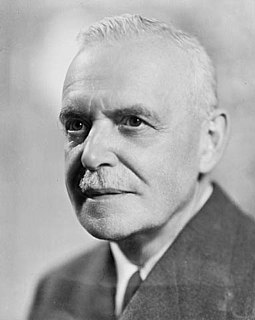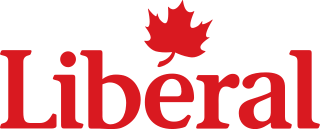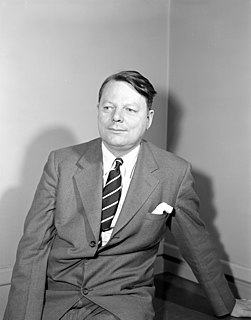Duncan Kenneth MacTavish (August 3, 1899 – November 15, 1963) was a Canadian Senator.
MacTavish was a millionaire and one of Canada's leading corporate lawyers. [1] He was a chief Liberal Party strategist and fundraiser and was an advisor to three Liberal Prime Ministers - William Lyon Mackenzie King, Louis St. Laurent and Lester Pearson and had also known Sir Wilfrid Laurier, a friend of his father, as a youth. [2]

William Lyon Mackenzie King, also commonly known as Mackenzie King, was the dominant Canadian political leader from the 1920s through the 1940s. He served as the tenth prime minister of Canada in 1921–1926, 1926–1930 and 1935–1948. He is best known for his leadership of Canada throughout the Second World War (1939–1945) when he mobilized Canadian money, supplies and volunteers to support Britain while boosting the economy and maintaining morale on the home front. A Liberal with 21 years and 154 days in office, he was the longest-serving prime minister in Canadian history. Trained in law and social work, he was keenly interested in the human condition, and played a major role in laying the foundations of the Canadian welfare state.

Louis Stephen St. Laurent was the 12th prime minister of Canada, from 15 November 1948 to 21 June 1957. He was a Liberal with a strong base in the Catholic francophone community, from which base he had long mobilised support to Prime Minister William Lyon Mackenzie King. His foreign policy initiatives transformed Canada from an isolationist ex-colony with little role in world affairs to an active "middle power". St. Laurent was an enthusiastic proponent of Canada's joining NATO in 1949 to fight the spread of Communism, overcoming opposition from some intellectuals, the Labor-Progressive Party, and many French Canadians. The contrast with Mackenzie King was not dramatic – they agreed on most policies. St. Laurent had more hatred of communism, and less fear of the United States. He was neither an idealist nor a bookish intellectual, but an "eminently moderate, cautious conservative man ... and a strong Canadian nationalist".

Sir Henri Charles Wilfrid Laurier was the seventh prime minister of Canada, in office from 11 July 1896 to 6 October 1911.
His father was Judge Duncan Byron MacTavish. He was educated in Ottawa and at Queen's University and Osgoode Hall Law School before being admitted to the bar in 1926. [2] In 1940, he married Janet Southam, daughter of Ottawa Citizen publisher Harry Stevenson Southam and a member of the Southam family. [2]

Queen's University at Kingston is a public research university in Kingston, Ontario, Canada. Founded on 16 October 1841, via a royal charter issued by Queen Victoria, the university predates Canada's founding by 26 years. Queen's holds more than 1,400 hectares of land throughout Ontario and owns Herstmonceux Castle in East Sussex, England. Queen's is organized into ten undergraduate, graduate, and professional faculties and schools.

Osgoode Hall Law School, commonly shortened to Osgoode, is the law school of York University in Toronto, Ontario, Canada. The school was originally founded by the Law Society of Upper Canada, and named for William Osgoode, an Oxford University graduate and barrister of Lincoln's Inn who was the first to serve as the Chief Justice of Upper Canada. The school signed an agreement of affiliation with York University in 1965 following a decision by the provincial government requiring all law schools to be affiliated with a university.

The Ottawa Citizen is an English-language daily newspaper owned by Postmedia Network in Ottawa, Ontario, Canada.
He began advising Mackenzie King during election campaigns in the 1920s and was named as executor of the late prime minister's estate. [2]
An executor is someone who is responsible for executing, or following through on, an assigned task or duty. The feminine form, executrix, may sometimes be used. The role of an executor should not be confused with that of an executioner, a person who carries out a death sentence ordered by a government or other legal authority.
He was president of the National Liberal Federation from 1952 to 1958 and had been a top Liberal campaign strategist for nearly 40 years at the time of his death. He was killed in an automobile collision on the Queen Elizabeth Way when returning home from the opening of the Royal Winter Fair in Toronto. [3]

The Liberal Party of Canada is the oldest and longest-serving governing political party in Canada. The Liberals form the current government, elected in 2015. The party has dominated federal politics for much of Canada's history, holding power for almost 69 years in the 20th century—more than any other party in a developed country—and as a result, it is sometimes referred to as Canada's "natural governing party".

The Queen Elizabeth Way (QEW) is a 400-series highway in the Canadian province of Ontario linking Toronto with the Niagara Peninsula and Buffalo, New York. The freeway begins at the Peace Bridge in Fort Erie and travels 139.1 kilometres (86.4 mi) around the western shore of Lake Ontario, ending at Highway 427. The physical highway, however, continues as the Gardiner Expressway into downtown Toronto. The QEW is one of Ontario's busiest highways, with an average of close to 200,000 vehicles per day on some sections. Major highway junctions are at Highway 420 in Niagara Falls, Highway 405 in Niagara-on-the-Lake, Highway 406 in St. Catharines, the Red Hill Valley Parkway in Hamilton, Highway 403 and Highway 407 in Burlington, Highway 403 at the Oakville–Mississauga boundary, and Highway 427 in Etobicoke. Within the Regional Municipality of Halton, between its two junctions with Highway 403, the QEW is signed concurrently with Highway 403.
MacTavish was appointed to the Senate of Canada in June 1963 by Prime Minister Pearson and served in the Senate for five months until the fatal accident. [3]

The Senate of Canada is the upper house of the Parliament of Canada, along with the House of Commons and the Monarch. The Senate is modelled after the British House of Lords and consists of 105 members appointed by the Governor General on the advice of the Prime Minister. Seats are assigned on a regional basis: four regions—defined as Ontario, Quebec, the Maritime provinces, and the Western provinces—each receive 24 seats, with the remaining portions of the country—Newfoundland and Labrador receiving 6 seats and the three northern territories each assigned the remaining one seat. Senators may serve until they reach the age of 75.
He was a senior partner in the Ottawa firm of Gowling, MacTavish, Osborne and Henderson and was an officer of 34 corporations as well as a member of the Board of Trustees of Queen's University. [2]
During World War II he served as deputy Judge Advocate General of the Royal Canadian Navy with the rank of captain. [2]
In the early 1950s he served as chairman of the Federal District Commission (the precursor of the National Capital Commission) which was responsible for creating what became the National Capital Region. [2]









